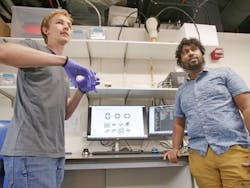Shapeshifting, Squishable Robots Inspired by Insects Could One Day Crawl Over Airplanes and Through Pipes
Key Highlights
- Research focuses on developing microbots that can actively change shape to adapt to their environment.
- These robots use static-electricity pulses to perform complex movements like walking on walls.
- Potential applications include aircraft engine inspections and spacecraft maintenance.
- The technology promises significant advancements in soft robotics and autonomous maintenance.
If you've ever watched a spider disappear into a crack that looks impossibly small, you've probably marveled at its agility and flexibility. Or maybe you were just happy it went somewhere besides inside your house. Nature seems to have perfected the art of movement in confined spaces, which is something engineers are still trying to master.
That's where Kaushik Jayaram, assistant professor at the University of Colorado Boulder, comes in. Backed by a $650,000 grant from the National Science Foundation and $1.4 million from the Air Force Research Laboratory, Jayaram is developing insect-inspired robots that can change their shape on command. His goal is to create tiny, agile, and adaptable robots capable of going where humans and machines cannot.
From Paperclip-Size Robots to Shapeshifting Swarms
Jayaram's earlier creation, the mCLARI, is a four-legged robot so small it can fit on a quarter and weighs less than half a penny. But even this microbot faces limitations when navigating complex environments. To make these systems more versatile, Jayaram's lab is working on robots that can actively alter their shape, stretching long and narrow to move quickly, or flattening wide for stability.
"If you want to be really fast, you can choose to be long and skinny," Jayaram explains. "If you want to be stable, then you can be wide. We need robots to be smart and shapeshift."
Unlike passive designs that compress to fit an opening, these future robots will transform in real time using pulses of electricity. The same static-electricity effect that makes a balloon stick to your hair will also enable them to walk up walls and even across ceilings.
Learning From Spiders
Inside Jayaram's lab, inspiration crawls on eight legs. Among the circuit boards and soldering irons are wolf spiders (my nightmare), fishing spiders, and crevice weaver spiders. These species can sprint, climb, and squeeze into the tightest crevices—all skills that roboticists hope to replicate mechanically.
By mimicking both the agility and flexibility of these spiders, Jayaram aims to overcome one of robotics' long-standing trade-offs: machines that are fast tend to be rigid, while flexible systems often lack power. The lab's research explores how to combine both qualities into a single, intelligent system that can adapt like a living organism.
Potential Applications
While still in early stages, the vision is clear. Imagine swarms of paperclip-sized robots crawling through aircraft engines to inspect for defects or maneuvering through underground conduits to locate damaged electrical wiring. In disaster zones, similar robots could slip through rubble to search for survivors or assess structural integrity before human responders enter.
The technology could even find use in spacecraft maintenance, where adaptability and lightweight construction are very important. With funding from both the NSF and Air Force Research Laboratory, the research points toward eventual use in aerospace, defense, and industrial maintenance environments that demand precision in hard-to-reach spaces.
Inspiring the Next Generation
Jayaram's team extends their research beyond the lab through educational outreach. Using origami-inspired robot kits, the group gives K–12 students the chance to design their own bug-like robots. Each kit lets kids choose how many legs to include, experiment with movement, and discover the connection between biology and engineering.
"We want kids to not be afraid of computers, and we're doing that using biology," says Jayaram. "Because everybody loves bugs."
The Road Ahead
Don't expect tiny robots to be crawling across airplane wings just yet. Jayaram estimates that practical deployment is still years away, but progress is accelerating. Within a decade, he believes these microbots could handle simple but critical maintenance and inspection tasks all on their own.
If successful, his research could represent a major leap for soft robotics—a field blending biology, materials science, and mechanical engineering to create machines that move and respond like living creatures.
From the chameleon-inspired 3D printers to spider-silk textiles, engineers continue to turn to the animal kingdom for inspiration. Now, thanks to insect-inspired shapeshifting robots, the next big advance in maintenance, search, and rescue might just crawl its way out of the lab and into the real world.
About the Author
Laura Davis
Editor-in-Chief, New Equipment Digest
Laura Davis is the editor in chief of New Equipment Digest (NED), a brand part of the Manufacturing Group at EndeavorB2B. NED covers all products, equipment, solutions, and technology related to the broad scope of manufacturing, from mops and buckets to robots and automation. Laura has been a manufacturing product writer for eight years, knowledgeable about the ins and outs of the industry, along with what readers are looking for when wanting to learn about the latest products on the market.

